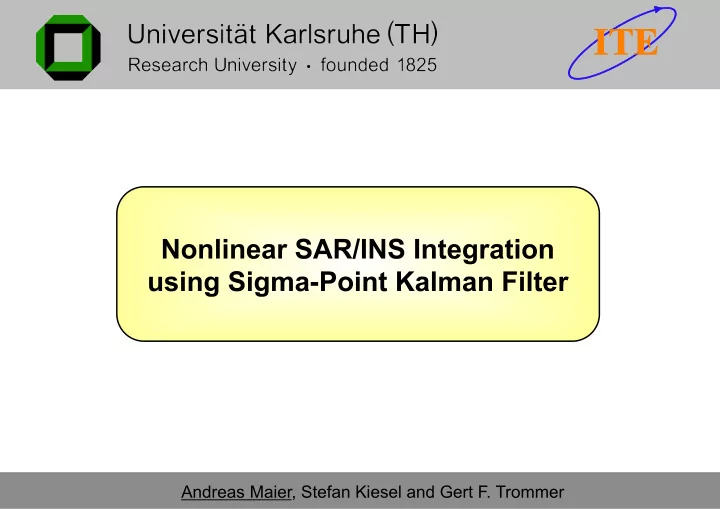

Andreas Maier, Stefan Kiesel and Gert F. Trommer
Outline • Objectives • SAR/INS System Overview trajectory • Synthetic Aperture Radar R • SAR/INS Integration • Simulation Results • Conclusion crossroads Andreas Maier Institute of Systems Optimization, University of Karlsruhe, Germany 1
Sensors Comparison of sensor characteristics • TRN • IMU – long term – short term – autonomous – autonomous – rough terrain • SAR (feature based) • GPS – long term – long term – autonomous – nonautonomous Andreas Maier Institute of Systems Optimization, University of Karlsruhe, Germany 2
Objectives • Implementation of Sigma-point Kalman filter for SAR/ INS integration • SAR/INS position accuracy analysis • Investigation of required feature update rates • SAR/INS in combination with – Baromeric altimeter – Terrain Referenced Navigation (TRN) Andreas Maier Institute of Systems Optimization, University of Karlsruhe, Germany 3
Feature Displacement • Features flight direction Unambiguous and well visible e. g. • Crossroads • Courses of rivers • Feature displacement Displacement between imaged feature and map feature is used for navigation update Andreas Maier Institute of Systems Optimization, University of Karlsruhe, Germany 4
System Overview Sensors SAR SAR processing antenna Feature Feature Measurement: data matching Displacement δ of the Navigation solution SAR image with respect to map feature SDA IMU Kalman filter Baro alt. Radar alt. Andreas Maier Institute of Systems Optimization, University of Karlsruhe, Germany 5
SAR Sensor z s-frame • Definition of sensor coordinates north n-frame – x in flight direction flight direction aircraft pos. – z upwards – y forms a right handed coordinate east system – Origin is located at ground level x • Transformation matrix down – Transformation from n to s-frame by y rotation around down-axis position: velocity: Andreas Maier Institute of Systems Optimization, University of Karlsruhe, Germany 6
SAR Sensor s-frame • Information of each z aircraft position reflection point form flight direction range and Doppler frequency • SAR-Processing x forms image in xy feature point coordinates y Andreas Maier Institute of Systems Optimization, University of Karlsruhe, Germany 7
Displacement • Map feature has to be transformed into s-frame coordinates • Nonlinear measurement equation depending on all position and velocity components Map feature: Measurement equation: Andreas Maier Institute of Systems Optimization, University of Karlsruhe, Germany 8
Sigma-Point Kalman Filter Sigma-point Kalman filter • 15-State SPKF has been implemented • Measurement noise includes matching errors and map errors • Sigma-point Kalman filter takes into account higher order terms automatically • Provides more accurate update in case of nonlinear measurement models State vector and measurement noise Augmented state vector construction Andreas Maier Institute of Systems Optimization, University of Karlsruhe, Germany 9
Sigma-Point Kalman Filter • Processing steps – Produce sigma-points – Transform by measurement equation – Calculate mean, covariance and correlation • Example of sigma-points weight Andreas Maier Institute of Systems Optimization, University of Karlsruhe, Germany 10
Sigma-Point Kalman Filter Sigma-point Kalman filtering is analogous to EKF-processing • – Calculate gain matrix – Calculate navigation error – Calculate new covariance matrix Correlation and covariance accurate to the second order term • SPKF EKF Andreas Maier Institute of Systems Optimization, University of Karlsruhe, Germany 11
Update step • Update by SAR measurement • Different sensor characteristics - 2 measurement equations - TRN update in regions of rough terrain • Independent measurements -SAR update during flight over smooth terrain - Change in depression angle covariance z covariance aircraft position feature position height meas. r y terrain x change in depression angle Andreas Maier Institute of Systems Optimization, University of Karlsruhe, Germany 12
Simulations Trajectory Sensor accuracies Navigation grade IMU Map error standard deviation: 3m start Matching error standard deviation: 7m Measurement noise 2% DTED level 1, 100m spacing Andreas Maier Institute of Systems Optimization, University of Karlsruhe, Germany 13
SAR/INS • Barometric altimeter aids height estimation • Navigation error depends on feature update rate • Feature updates in the scale of a few minutes needed Andreas Maier Institute of Systems Optimization, University of Karlsruhe, Germany 14
SAR/TRN/INS • TRN: No accurate estimation over flat area • SAR prevents increasing position errors over smooth terrain • TRN leads to reliable navigation information even if no SAR- features are available • TRN and SAR show different characteristics Andreas Maier Institute of Systems Optimization, University of Karlsruhe, Germany 15
Conclusion • SAR/INS is able to provide 3-dimensonal navigation information • Autonomous navigation achievable by SAR/INS • Feature updates in the scale of a few minutes required • SAR in combination with low cost TRN is optimal due to complementary sensor characteristics. Andreas Maier Institute of Systems Optimization, University of Karlsruhe, Germany 16
Andreas Maier, Stefan Kiesel and Gert F. Trommer
Andreas Maier Institute of Systems Optimization, University of Karlsruhe, Germany 18
Andreas Maier Institute of Systems Optimization, University of Karlsruhe, Germany 19
SAR/INS • Barometric altimeter aids height estimation • Navigation error depends on feature update rate • Feature updates in the scale of a few minutes needed Andreas Maier Institute of Systems Optimization, University of Karlsruhe, Germany 20
Terrain Referenced Navigation Measurement equation Measurement matrix terrain Update step Reasonable terrain roughness required Andreas Maier Institute of Systems Optimization, University of Karlsruhe, Germany 21
Recommend
More recommend